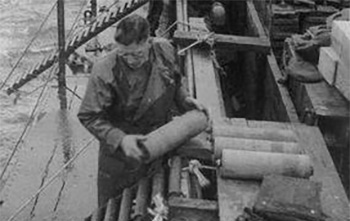With a constant flow of World War II munitions dumped in the Irish Sea in the Beaufort Dyke between Scotland and Northern Ireland and now washing up on our beaches, we do have to ask the question: are our seas and beaches safe?
Bernard Moffat of the Celtic League, an organisation set up with Irish Sea stakeholders to ensure safety to seafarers and fishermen, recently reported on an interesting story on the BBC web pages about the discovery of the wreck of a U Boat which sank 100 years ago off Stranraer. The story is surrounded with subterfuge and mystery and even has a ‘horrible sea monster’ in the mix:
http://www.bbc.co.uk/ne…/uk-scotland-south-scotland-37691283

Bernard said: “However, it wasn’t that which interested me in the story but it was the manner and reason why the wreck had after all this time has been discovered.
There is something much nastier than mythical sea monsters in the Beaufort Dyke area of the North Channel area a vast section of which was used by the British military for over seventy years as a dumping ground for munitions.
“Indeed when the Celtic League ran a campaign to elicit information twenty-five years ago even we were shocked when the UK Ministry of Defence finally admitted a staggering 1,000,000 tonnes of munitions had been dumped.
“The munitions which include conventional and chemical weapons are concentrated in the main dump site an area 12 x 8 miles in the centre of the North Channel.
But bad weather conditions when the weapons were disposed resulted in a large area outside the parameters of the official dumping ground being littered with munitions.
“There is little that can be done to ‘clean up’ the Beaufort Dyke dumpsite and the consensus is it should be left undisturbed. That consensus was reinforced when after the construction of a utility interconnector between Scotland and Ireland, disturbed munitions were washed up on coasts in Scotland, the Isle of Man and Eastern Ireland as far south as Louth.
“The munitions were for the most part highly toxic phosphorous bombs and shells which when beached and dried out spontaneously combust given of acrid fumes.
“Beaches in the effected areas carried notices warning about them. The recent discovery of the U Boast wreck is linked to the laying through the dump site area of twin electricity cables – the so called Western Link from Ayrshire in Scotland to the NW of England.
“The Western Link goes right through the dyke and its construction is well in hand.
I don’t think they’ll come across any sea monsters but if they do disturb the vast quantity of munitions along the route expect nasty things to start washing up on our beached anytime soon!”
Related links – Interconnector:
http://www.westernhvdclink.co.uk/documents.aspx
http://www.offshorewind.biz/…/western-link-hvdc-cable-layi…/
Related links – Beaufort Dyke:
https://www.facebook.com/permalink.php?story_fbid=1005659082816186&id=805941286121301&substory_index=0https://www.facebook.com/permalink.php?story_fbid=1005855699463191&id=805941286121301&substory_index=0https://www.facebook.com/permalink.php?story_fbid=1007413705974057&id=805941286121301&substory_index=0
























